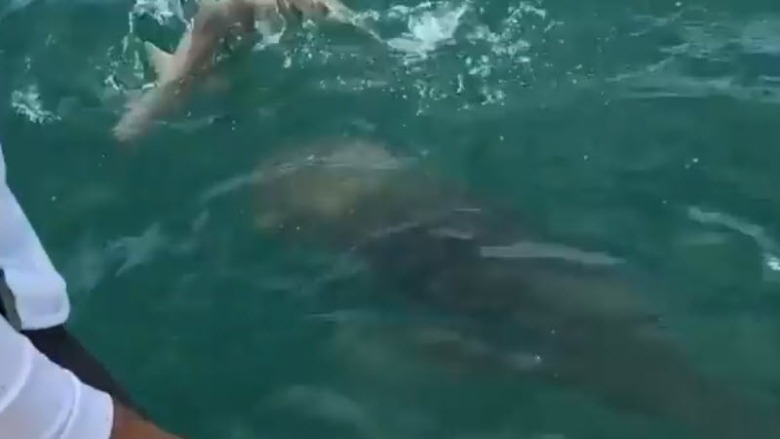
A group of fishermen on a charter boat in Florida were shocked when a 3-foot shark they had just hooked was eaten by a Goliath grouper. The fish can be seen in a video swimming up to the shark and then swallowing it whole. The video was posted on Facebook by the charter, Everglades Fishing Company.
“He just sucked it in. I don’t remember ever seeing anything this crazy,” Michelle Wheeler, who runs Everglades Fishing Company with her husband, Captain Jimmy Wheeler, told Fox News. “That same grouper later swallowed a stingray — or manta ray. They have become a nuisance, according to a lot of fishermen. They’re eating everything.” Wheeler said the Goliath grouper later spit out the shark. “We snorkel and see they’ll just go by a fish and suck it in. They’re huge. They didn’t get that way from not eating,” she told Fox News.
The wild video was filmed in July 2018 off the coast of Everglades City, Florida. You can watch the video here:
The Everglades Fishing Company’s video was not the first time that a video of a Goliath grouper eating a shark went viral. A 2014 video with more than 6.5 million views shows a Goliath grouper eating a 4-foot shark in one bite:
A 2009 video shows a similar incident:
And another shows a larger shark out-fighting a Goliath grouper:
According to the Florida Fish and Wildlife Conservation Commission, the Goliath grouper is, “the giant of the grouper family, the Goliath (formerly called jewfish) has brown or yellow mottling with small black spots on the head and fins, a large mouth with jawbones that extend well past its small eyes, and a rounded tail. It also has five dark body bands or stripes that are most visible on young Goliath.”
The commission says that harvesting and possessing the Goliath grouper has been prohibited in Florida since 1990, because it is a protected species. The fish must be immediately returned to the water, free, alive and unharmed if caught. “Large Goliath groupers should be left in the water during release. The skeletal structure of large goliath grouper cannot adequately support their weight out of the water without some type of damage. If a large Goliath is brought on-board a vessel or out of the water, it is likely to sustain some form of internal injury and therefore be considered harvested,” the commission says.
According to the wildlife commission, the Goliath grouper can reach 800 pounds and be over 8 feet in length. The Florida record is a 680-pound Goliath grouper caught off Fernandina Beach in 1961. The population of Goliath groupers began to decline in the 1970s and 1980s, according to the commission.
“There are a number of factors that contributed to the decline of Goliath grouper, included declines in juvenile habitats, strong site fidelity and being long lived. Goliath form large aggregations and these often occur in areas where fishermen congregate. Goliath are also susceptible to large scale mortality events such as cold temperatures and red tide blooms,” the conservation commission says. “When not feeding or spawning, adult Goliath groupers are generally solitary, sedentary and territorial. Before the Goliath grouper reaches full-size it is preyed upon by barracuda, king mackerel and moray eels, as well as sandbar and hammerhead sharks. Once fully grown, humans and large sharks are the Goliath grouper’s only predators.”
Since the restriction on catching Goliath groupers in 1990, “Goliath grouper populations have substantially recovered since the harvest prohibition took effect. There have been increases in abundance in certain areas (e.g., Tampa Bay, Charlotte Harbor and the Ten Thousand Islands), and the distribution of Goliath grouper populations has extended into areas of its former range throughout Florida, including the Big Bend and Panhandle regions,” the conservation commission says.
According to the conservation commission, “Goliath grouper are opportunistic predators and feed mostly on slow-moving, bottom-associated species. Calico crabs make up the majority of their diet, with other invertebrate species and fish filling in the rest. Goliath grouper will occasionally feed on fish that are struggling on a fishing line, but they have not been shown to actively hunt down fast, free swimming fish such as snappers and groupers. Prey is ambushed, caught by a rapid expansion and opening of the mouth that allows prey to be sucked in and swallowed whole.”
